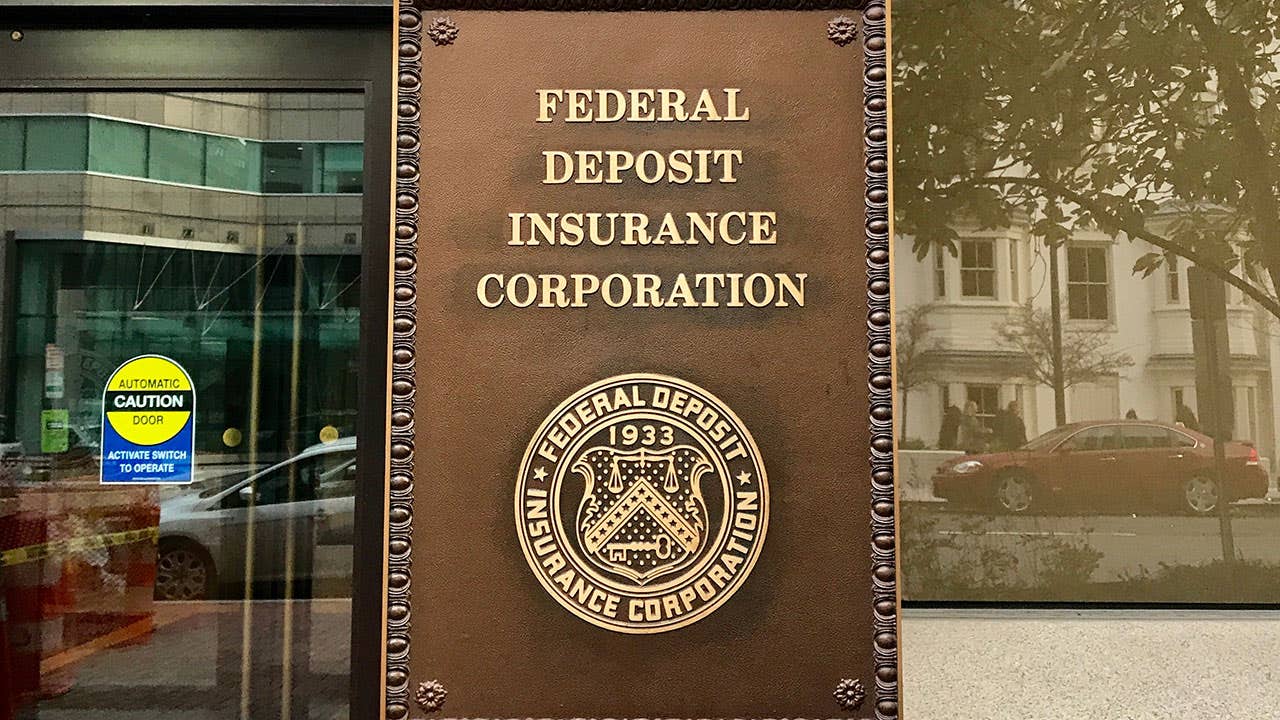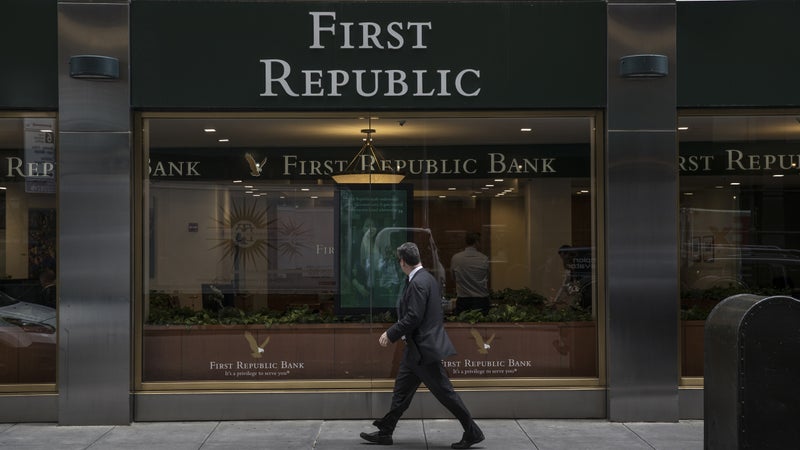FDIC insurance: What it is and how it works

The Bankrate promise
At Bankrate we strive to help you make smarter financial decisions. While we adhere to strict , this post may contain references to products from our partners. Here's an explanation for .
Key takeaways
- FDIC insurance is backed by the full faith and credit of the U.S. government and guarantees bank consumers that their money is safe for up to a limit of $250,000 per depositor, per FDIC-insured bank, per ownership category.
- The FDIC was created in 1933 to protect consumers during bank failures and since then has been a crucial backstop for financial uncertainty.
- FDIC insurance covers traditional bank deposit products, such as checking and savings accounts, but doesn't cover investments or payment providers such as PayPal.
- In the event of a bank failure, the FDIC will either transfer funds to another insured bank or issue a check, but it's recommended to stay within the insurance limits for easy access to your insured funds.
Some of the largest bank failures in U.S. history happened just last year. The one year anniversary of the failures of Silicon Valley Bank, Signature Bank and First Republic in 2023 are three good reasons to review the deposit insurance for your bank accounts now. If your bank is insured by the Federal Deposit Insurance Corp. (FDIC), your money in that bank is protected by the federal government, but up to a limit.
Here’s what you need to know about how your money is backed by the government through the FDIC and the limits of such insurance.
What is FDIC insurance?
The FDIC is the agency that insures deposits at member banks in case of a bank failure. FDIC insurance is backed by the full faith and credit of the U.S. government.
The FDIC insures up to $250,000 per depositor, per FDIC-insured bank, per ownership category. This guarantees consumers that their money is safe if a bank fails, as long as your balances are within the limits and guidelines.
FDIC insurance: What’s covered and what isn’t
What FDIC insurance covers
FDIC insurance covers traditional bank deposit products, including checking accounts, savings accounts, certificates of deposit, Negotiable Order of Withdrawal (NOW) accounts and money market deposit accounts.
The FDIC classifies deposit accounts into several ownership categories. These include:
- single accounts
- joint accounts
- corporate accounts
- retirement accounts
Individual depositors are insured up to $250,000 per each ownership category, per FDIC-insured bank. If an account holder has more than $250,000 in accounts that fall under a single ownership category at one bank, anything over that amount isn’t insured.
An individual account is insured separately from a joint account, since they’re distinct ownership categories. Joint accounts are insured for $250,000 per co-owner, so a $500,000 CD owned by two joint account holders would be fully insured because each account holder is insured for up to $250,000.
Likewise, accounts owned by corporations or partnerships are also considered a distinct ownership category. That means that businesses with more than $250,000 in their bank account won’t get the excess amount insured, unless they split the funds between different banks, since each bank gets its own insurance limits.
If, for example, Sarah has $250,000 in a joint savings account and $200,000 in a checking account as a single owner, her money is fully insured. Even though the total deposits exceed $250,000, the money is split between different ownership categories, so each account is insured separately.
On the other hand, if Cameron has $200,000 in a high-yield savings account and $125,000 in a CD at the same bank in his name alone, $75,000 of his deposits won’t be insured. To make sure his money is entirely federally insured, he could open an account at a separate FDIC-insured bank or transfer some of the money into a jointly owned account.
FDIC insurance also protects interest earnings, as long as the principal and interest combined don’t exceed the $250,000 cap. Now, if you have $248,000 in a CD account that has earned $2,000 in interest, the full amount is covered because your account doesn’t exceed the insurance limit.
What the FDIC doesn’t cover
The FDIC doesn’t insure investments.
Here are some items that aren’t bank deposits and aren’t covered by FDIC insurance, even if they’re in an account with a bank’s name on it or if you bought one at a bank:
The FDIC also doesn’t cover the contents of your safe-deposit box either.
Payment providers, such as PayPal and Venmo, also don’t qualify for FDIC insurance because they aren’t banks. There are some exceptions, though. PayPal offers pass-through FDIC insurance for funds that are directly deposited to a PayPal account. Note that it isn’t PayPal itself that comes with the insurance, but rather the funds are held in a custodial account at an FDIC-insured bank that partners with PayPal.
If you’re not sure whether all your deposits are FDIC-insured, talk to a bank representative or use the FDIC’s Electronic Deposit Insurance Estimator (EDIE) and enter information about your accounts.
How to guarantee all of your deposits are insured
Depending on your circumstances, you might be able to keep your bank deposits insured by keeping your cash in different ownership categories.
For example, joint account ownership offers more protection than single account ownership because each account owner is insured up to $250,000. So, if a couple had $500,000 in a joint savings account, their money would be insured by the FDIC. A savings account with a single owner with $500,000 would only be half insured.
Trusts also afford more protection. If you have a revocable trust, as many as five beneficiaries are insurable for up to $250,000 each.
Spreading your money around to different FDIC-insured banks is another way to maximize insurance protection. There are bank networks that can do that for you.
The table below shows how different account ownership categories can affect your deposit insurance coverage.
| DIFFERENT TYPES OF ACCOUNT OWNERSHIP | INSURED | UNINSURED |
|---|---|---|
| Account holder A (single ownership) Savings: $50,000 CD: $250,000 |
$250,000 | $50,000 |
| Account holder B (joint ownership) Savings: $150,000 CD: $325,000 |
$500,000 | $0 |
| Account holder C (revocable trust: up to 5 beneficiaries insured for up to $250,000) Beneficiary 1: $250,000 Beneficiary 2: $250,000 Beneficiary 3: $250,000 Beneficiary 4: $250,000 Beneficiary 5: $250,000 |
$1.25 million | $0 |
How the FDIC pays you back after a bank fails
Depositors don’t need to file insurance claims to recoup their deposits. Nor do they need to apply for deposit insurance when they open up a bank account at an FDIC-insured institution.
When a bank fails, the FDIC pays depositors by giving them an account at another insured bank in the amount equal to what they had at the failed bank, up to the insurance limits. If there’s no bank to acquire the deposits, the FDIC simply issues the depositor a check within a few days.
Note that while the FDIC guarantees depositors won’t lose any money up to the covered amount, there’s no guarantee that if the funds move to a new bank they will earn the same interest rate. However, depositors can always withdraw the funds after a new bank acquires them with no penalty.
It can take a few years to recover deposits that exceed the insurance limit. As the FDIC sells off a failed bank’s assets, it typically issues periodic payments to depositors. Funds that exceed insurance limits are repaid on a cents-on-the-dollar basis.
Silicon Valley Bank, for example, didn’t have insurance coverage for most of its deposits when it failed, according to regulatory filings. The FDIC announced it would pay back uninsured deposits in receivership certificates and dividend payments as it sells the closed bank’s assets.
Still, it’s best to make sure your deposits don’t exceed the FDIC limits, so you can readily access your insured funds as soon as the failed bank is acquired by another bank or the FDIC pays off closed accounts.
FAQs about FDIC insurance
-
The FDIC was created in 1933 to protect consumers when financial institutions fail and are forced to close their doors.
During the Great Depression, insurance for banks was not available. So when banks failed, Americans lost their savings. Now when banks fail, the FDIC steps in to protect depositors and their money.
“Bank failures are unusual,” says Mark Hamrick, Bankrate’s senior economic analyst and Washington bureau chief. “But when they happen, affecting covered institutions, FDIC coverage is important.”
Having that insurance is a crucial backstop to financial uncertainty. Following a wave of bank collapses, including those of Silicon Valley Bank and First Republic Bank, consumers can ensure that all of their deposits within the insurance guidelines are guaranteed by the government, and they don’t have to worry about withdrawing their money from the bank.
Generally, you can continue to bank as if a failure didn’t happen immediately after a bank failure is announced.
-
The vast majority of banks, including online-only banks, offer deposit customers FDIC insurance.
An online bank that’s FDIC-insured has the same FDIC coverage as a brick-and-mortar bank. If you open an account with an FDIC-insured bank, you are automatically enrolled in the federal insurance.
It’s rare for a bank not to have FDIC insurance, but there are exceptions. Bank of North Dakota, for example, is not FDIC-insured. Instead, it is backed by the full faith and credit of the State of North Dakota.
Credit unions are regulated differently from banks and have their own federal deposit insurance through the National Credit Union Share Insurance Fund (NCUSIF). The fund was created by Congress in 1970 to insure deposits in member credit unions.
It’s administered by the National Credit Union Administration (NCUA), which charters, regulates and monitors federal credit unions. The insurance is similar to what the FDIC provides, with a $250,000 cap for each account and owner.
Bottom line
In the event of a bank failure, FDIC insurance provides crucial protection for consumers’ deposits. With up to $250,000 in coverage per depositor, per FDIC-insured bank, per ownership category, it’s important for individuals and businesses to understand the limits and guidelines of this insurance.
While most banks, including online-only banks, offer FDIC insurance, it’s still important to confirm this coverage and make sure all deposits fall within the insured limits. By spreading deposits across different ownership categories, individuals can maximize their insurance protection. In the unlikely event of a bank failure, the FDIC will pay depositors back by transferring their funds to another insured bank or issuing a check. It’s always best to stay within the insurance limits to ensure quick and easy access to insured funds.
–Former Bankrate staff writer René Bennett contributed to a previous version of this article.

